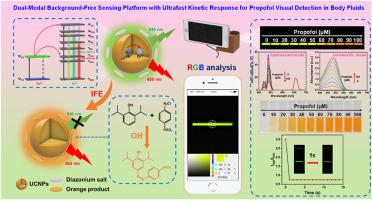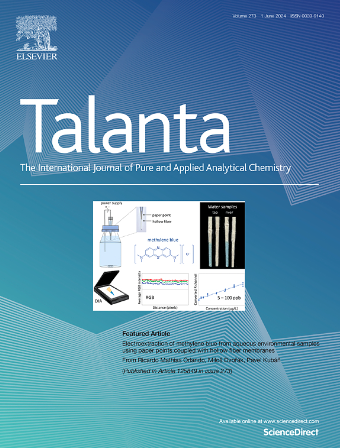体液中异丙酚视觉检测的超快速动力学响应双峰无背景传感平台
IF 6.1
1区 化学
Q1 CHEMISTRY, ANALYTICAL
引用次数: 0
摘要
体液中异丙酚的快速定量检测对保障医疗安全和遏制药物滥用具有重要意义。荧光法是检测异丙酚的一种有效方法。然而,短波激发产生的背景荧光影响了检测灵敏度,缓慢的动力学响应导致检测时间延长。本研究研制了一种近红外光激发下无背景、快速响应的上转换纳米探针,用于异丙酚的定量检测。利用掺杂镧系上转换纳米粒子(UCNPs)和异丙酚与重氮盐之间的超快显色反应,该显色产物可以在1 s内选择性猝灭绿色上转换发光(UCL),同时保留红色UCL。因此,建立了一个具有超快动力学响应能力的高灵敏度、多信号输出的传感系统。所设计的传感平台系统地消除了自身荧光,从而提高了检测灵敏度。在优化条件下,比色模式下的检测限为105 nM,发光模式下的检测限为34 nM。进一步研制了一种灵敏度高、检测速度快的便携式传感装置,为检测人体体液中药物浓度提供了一种新方法。本研究为体液中药物浓度的快速现场检测提供了一种新的方法。本文章由计算机程序翻译,如有差异,请以英文原文为准。

Dual-modal background-free sensing platform with ultrafast kinetic response for propofol visual detection in body fluids
Rapid and quantitative detection of propofol in body fluids is of great significance in ensuring medical safety and curbing drug abuse. Fluorimetry is an effective method for the detection of propofol. However, background fluorescence generated by short-wavelength excitation compromises detection sensitivity, and slow kinetic responses lead to prolonged detection time. In this study, a background-free, rapid-response upconversion nanoprobe excited by near-infrared light was developed for the quantitative detection of propofol. Leveraging lanthanide-doped upconversion nanoparticles (UCNPs) and the ultrafast chromogenic reaction between propofol and diazonium salts, the chromogenic product can selectively quench green upconversion luminescence (UCL) within 1 s while preserving red UCL. Consequently, a highly sensitive, multi-signal output sensing system with ultrafast kinetic response capabilities was established. The designed sensing platform systematically eliminated autofluorescence, thus enhancing detection sensitivity. Under optimized conditions, the limit of detection (LOD) was determined to be 105 nM for colorimetric mode and 34 nM for luminescent mode. A portable sensing device was further fabricated, exhibiting excellent sensitivity and rapid detection capabilities, which offered a novel approach for detecting drug concentrations in human body fluids. This study provides a new approach for the rapid on-site detection of drug concentrations in body fluids.
求助全文
通过发布文献求助,成功后即可免费获取论文全文。
去求助
来源期刊

Talanta
化学-分析化学
CiteScore
12.30
自引率
4.90%
发文量
861
审稿时长
29 days
期刊介绍:
Talanta provides a forum for the publication of original research papers, short communications, and critical reviews in all branches of pure and applied analytical chemistry. Papers are evaluated based on established guidelines, including the fundamental nature of the study, scientific novelty, substantial improvement or advantage over existing technology or methods, and demonstrated analytical applicability. Original research papers on fundamental studies, and on novel sensor and instrumentation developments, are encouraged. Novel or improved applications in areas such as clinical and biological chemistry, environmental analysis, geochemistry, materials science and engineering, and analytical platforms for omics development are welcome.
Analytical performance of methods should be determined, including interference and matrix effects, and methods should be validated by comparison with a standard method, or analysis of a certified reference material. Simple spiking recoveries may not be sufficient. The developed method should especially comprise information on selectivity, sensitivity, detection limits, accuracy, and reliability. However, applying official validation or robustness studies to a routine method or technique does not necessarily constitute novelty. Proper statistical treatment of the data should be provided. Relevant literature should be cited, including related publications by the authors, and authors should discuss how their proposed methodology compares with previously reported methods.
 求助内容:
求助内容: 应助结果提醒方式:
应助结果提醒方式:


